Abstract
In an image-intensifier angiographic system, the tube potential is commonly regulated in ranges from 75 to 90 kV for digital subtraction angiography (DSA) and fluoroscopy in transarterial chemoembolization therapy (TACE) for hepatocellular carcinoma. The purpose of this study was to investigate whether or not a 120-kV tube potential could be used for DSA and fluoroscopy in TACE to decrease the skin dose. Forty-three patients administered TACE were randomly allocated into two groups: TACE was performed using standard-kilovoltage (75- to 90-kV) DSA and fluoroscopy modes (group A; n = 20) or using high-kilovoltage (120-kV) modes (group B; n = 23). The peak skin dose was compared between the groups. One case in group A was excluded from the study because the HCC nodule was not depicted on DSA. The peak skin dose (mGy) for group A was 383.6 ± 176.5 and that for group B was 265.1 ± 145.1. The peak skin dose was decreased by 31% in the 120-kV mode, a statistically significant difference (t-test, p = 0.022). We conclude that the use of 120 kV tube potential for DSA and fluoroscopy may be one option for performing TACE while decreasing the skin dose.




Similar content being viewed by others
References
Miller DL, Balter S, Noonan PT, et al. (2002) Minimizing radiation-induced skin injury in interventional radiology procedures. Radiology 225:329–336
International Commission of Radiological Protection (2000) Avoidance of radiation injuries from medical interventional procedures. ICRP Publication 85. Ann ICRP 30:7–67
Irie T (2004) Realtime digital magnification of the fluoroscopic and digital subtraction angiography images: randomaized prospective study to show dose reduction during segmental chemoembolization for hepatocellular carcinoma. J Vasc Interv Radiol 15:165–168
Gkanatsios NA, Huda W, Peters KR (2002) Effect of radiographic techniques (kVp and mAs) on image quality and patient doses in digital subtraction angiography. Am Assoc Phys Med 29:1643–1650
Servomaa A, Tapiovaara M (1998) Organ dose calculation in medical X ray examinations bu the program PCXMC. Radiat Protect Dosimetry 80:213–219
Iida H, Horii J, Chabatake M, et al. (2004) Evaluation and estimation of entrance skin dose in patients during diagnostic and interventional radiology procedures. Nippon Hoshasen Gijyutsu Gakkai Zasshi 60:126–135 [in Japanese]
Ishiguchi T, Nakamura H, Okazaki M, et al. (2000) Radiation exposure to patient and radiologist during transcatheter arterial embolization fro hepatocellular carcinoma. Nippon Igaku Hoshasen Gakkai Zasshi 60:839–844 [in Japanese]
Miller DL, Balter S, Cole PE, et al. (2003) Radiation dose in interventional radiology procedures: the RAD-IR study. J Vasc Interv Radiol 14:711–727
Srinivas Y, Wilson DL (2002) Image quality evaluation of flat panel and image intensifier digital magnification in X-ray fluoroscopy. Med Phys 29:1611–1621
Suzuki S, Furui S, Kobayashi I, et al. (2005) Radiation dose to patients and radiologists during transcatheter arterial embolization: comparison of a digital flat-panel system and conventional unit. AJR 185:855–859
Kato H (2004) Method of calculating side scatter factor for diagnostic X-rays. Nippon Hoshasen Gijyutsu Gakkai Zasshi 60:118–125 [in Japanese]
Trout ED, Kelley JP (1972) Scattered radiation from a tissue-equivalent phantom for X rays from 50-300 kVp. Radiology 104:161–169
Author information
Authors and Affiliations
Corresponding author
Rights and permissions
About this article
Cite this article
Irie, T., Satou, R. Use of 120 Kilovolt Tube Potential for Digital Subtraction Angiography and Fluoroscopy in an Image-Intensifier Angiographic System: Decrease of Skin Dose in Transarterial Chemoembolization Therapy for Hepatocellular Carcinoma. Cardiovasc Intervent Radiol 30, 901–905 (2007). https://doi.org/10.1007/s00270-007-9055-0
Received:
Revised:
Accepted:
Published:
Issue Date:
DOI: https://doi.org/10.1007/s00270-007-9055-0




